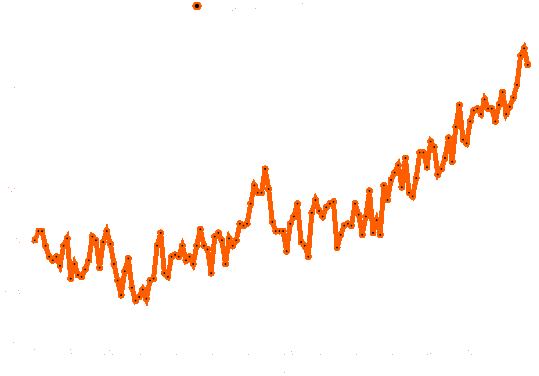Science can be beautiful. Art can be informative.
The urgency of climate change is a pressing issue of our time. Scientists have done their job superbly demonstrating causes for why and how our planet is warming due to Human activities. They have done it by making long term measurements of atmospheric CO2 levels and deep drilling of polar ice cores. The scientific facts are all very clear indicating excessive fossil fuel use must end. However the message is clearly not being heard by policy makers as emissions continue to rise. The scientific art piece “In Nomine Terra Calens” is an attempt to convey urgency of global warming.
The latin name “In Nomine Terra Calens” translates to “In the name of a warming earth.” For this instrumental Baroque composition seismologist Dr. Jones came up with a mathematical scaling function that converts average surface temperature data of the Earth that spans 138 years from 1880 until 2013 into music. There are 12 half-steps in an octave. Every 0.03 degrees centigrade represents a half-step in pitch. Accordingly, Dr. Jones imposed an octave change for every 0.36 degrees centigrade difference. She initiated the piece at a pitch at the lowest note on the instrument for the lowest temperature days. When the temperature data reached the year 2013, the composition moved three octaves upwards where it also reached the limit of the comfortable range for a Viola da Gamba. She had to go another fifth higher to accommodate the rise in temperature since 2013 pushing into the highest note that can be played on the instrument.
Musical keys evoke particular psychological moods. B flat has a distinct melancholic character. Choice of this key in a composition carries a deliberate feeling of ultimate suffering and lamentation (Recall the third movement of Chopin’s Death March sonata No.2 in B-flat minor or the second movement of Tchaikovsky’s Symphony No.4). Therefore the choice is spot on to reflect the size and seriousness of the matter. B flat has the potential to transform from sad (B flat minor) into a heroic cheerful tone (B flat major). In the face of rising climate challenge perhaps if we take action towards right direction we can change the character of our future. We can turn a requiem for the Anthropocene into a positive progressive coming.
This is certainly not the only attempt to convey the urgency of climate change and there are a few other collaborative projects as well:
The piece is performed by four viols a.k.a. Viola da Gamba. The bass viol plays the temperature data. The visualization by Ming Tai, El Ogorodova, and Christopher Yoon depicts the rising temperatures as smooth colored spheres with annotations of historical milestone events. The poignant bass line represents the rise of global temperature. It reaches final with a suspense of unresolved future:
“I end In Nomine Terra Calens with a stripping away of harmonies to finally land on one, lone, very high note. I end without direction to represent the uncertain future. We stand at a decision point where the future of the world really rests on our decisions. –Dr. Lucy Jones”



1 Comment